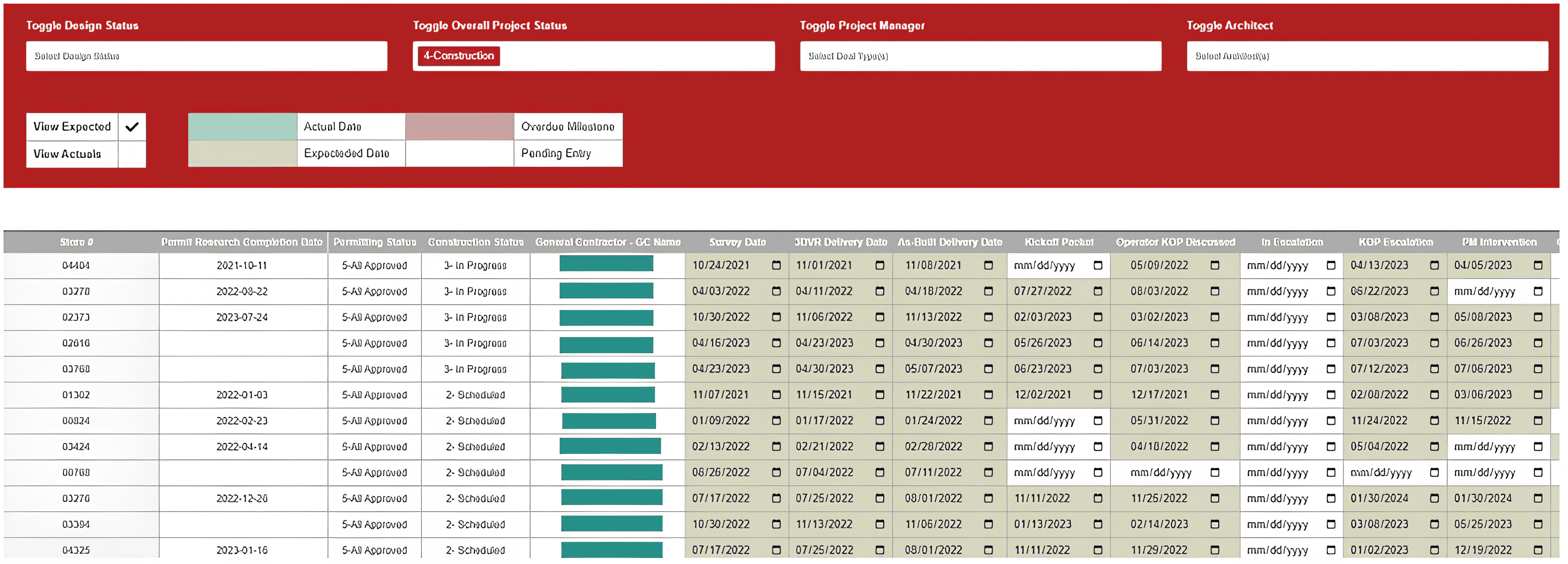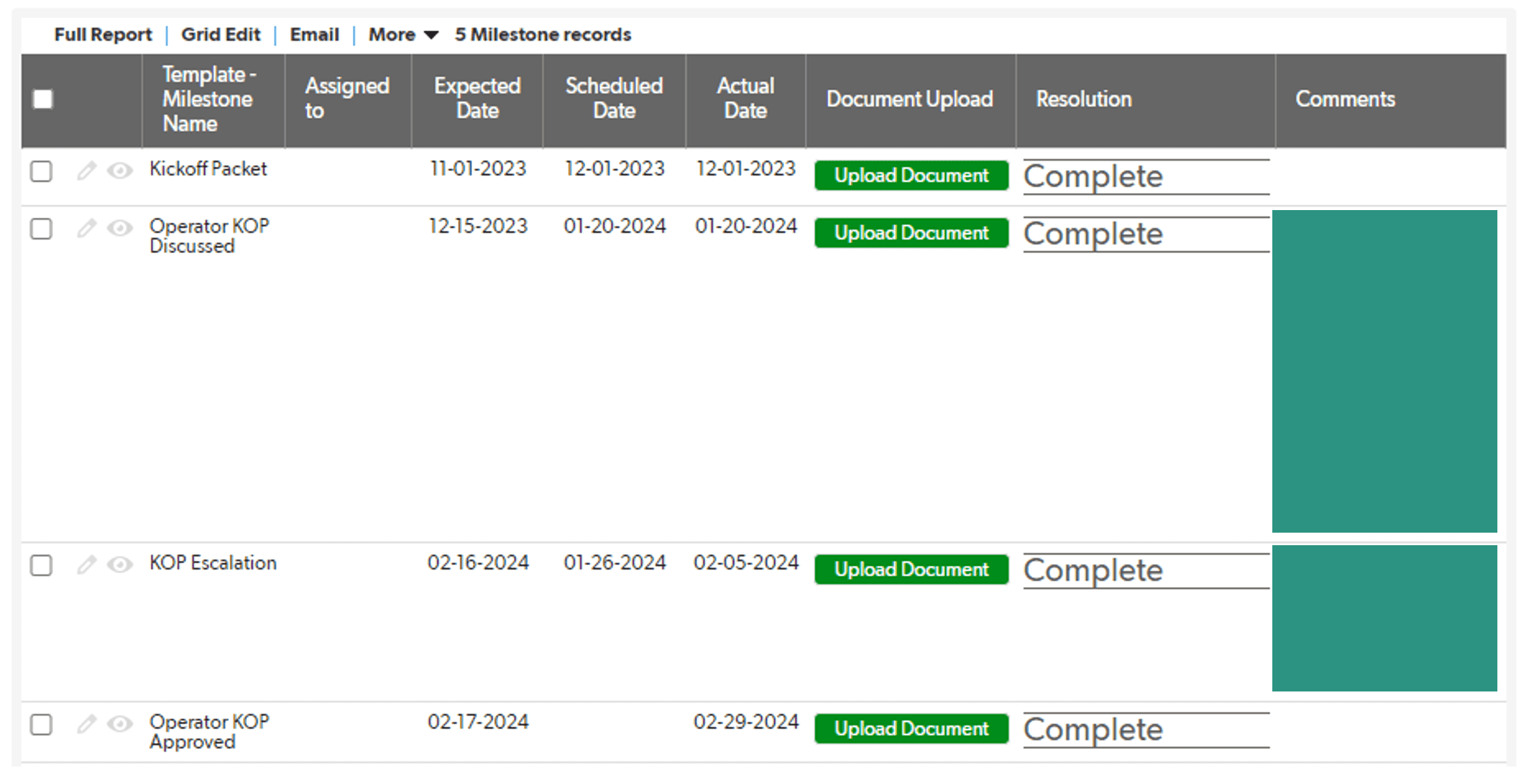The Challenge: Managing 3,000 Projects on a Broken System
Rolling out drive-thru upgrades at over 3,000 stores meant managing thousands of construction projects simultaneously—each with its own dependencies, approvals, and site constraints.
The client had piloted a Quickbase tool during a smaller initiative, but scaling it exposed critical limits. Manual workflows broke down. Milestones were missed. And without a clear view into bottlenecks, delays began to snowball.
This put the schedules, budgets, and team bandwidth at risk.
They needed a way to manage escalation paths, approvals, and task logic at scale before operational complexity overwhelmed their rollout.
Our Solution: Phase Tracking and Management in Custom App
Quandary Consulting Group built a custom Quickbase application to help the client manage thousands of simultaneous construction projects, each with its own milestones, approvals, and bottlenecks.
The custom application reflected real-world complexity, including project phases, task dependencies, and required executive reviews. It automated milestone forecasting based on actual task completion dates and centralized all project data on a single platform.
To handle volume, we introduced nationwide batching. Store operators could volunteer for upgrades, and site data was grouped for streamlined executive review and approval.
The system also flagged issues requiring escalation, such as permitting delays and architectural conflicts. This made it easier for teams to identify complications early and maintain consistent data across sites.


Key Features:
- Nationwide batching: Sites were grouped to streamline executive approvals and avoid review bottlenecks.
- Centralized milestone tracking: All project data lived in one place, mapped to real-world construction phases.
- Automation-assisted workflows: User updates trigger the next required step, reducing missed tasks and manual follow-up.

Our Process: From Discovery to User Testing
The project spanned six months, beginning with a two-month discovery phase to understand how construction workflows, approvals, and escalations were executed across thousands of stores. We then translated those processes into a system with built-in logic anda clear user flow.
Key Steps:
- Mapped milestone logic with the project team to define construction phases, task dependencies, and escalation paths that would drive the system
- Visualized workflows through diagrams and user flows to align stakeholders and guide development
- Migrated and normalized data using custom scripts to restructure permits, contracts, and legacy records into the new system
- Developed and tested automations that triggered tasks and deadlines based on real project behavior
- Ran hands-on user testing with internal teams to surface friction points and refine usability ahead of launch
The Roadblocks: Incomplete Data and Unusable Logic
One major challenge was the state of the legacy data. The client’s previous workflow relied heavily on manual entry, and key fields such as task predecessors were often left blank or inconsistently filled out.
This made it difficult to build reliable logic or surface historical patterns. To resolve this, we worked closely with the client’s team to identify gaps, clean records, and reestablish milestone relationships.
This hands-on effort was critical to stabilizing the new system and to avoiding errors that could derail thousands of active projects.
The Toolstack

- Quickbase: Used to model real-world construction workflows without starting from scratch. Its low-code flexibility enabled us to automate milestone logic, manage escalations, and centralize site data at a scale that supported thousands of projects.
The Results: 3,000 Projects. 600 Sites. One App.
The system now tracks over 3,000 projects across 600 active construction sites, giving operations full visibility from planning through completion.
Teams no longer rely on scattered spreadsheets. Milestones, escalations, and site statuses are centralized, making it easier to spot issues early and avoid cascading delays.
With standardized workflows and historical data in one place, leadership can pinpoint recurring bottlenecks, underperforming contractors, and high-risk sites.
At the store level, upgraded drive-thrus have increased throughput, reduced wait times, and simplified daily operations for on-site teams.
Key Results:
- 600+ construction sites tracked in one system
- Faster detection of delays and bottlenecks
- Recurring contractor issues flagged early
- Shorter customer wait times
- Smoother workflows for on-site staff
Client Overview:
The client is a major U.S. restaurant brand with thousands of locations nationwide. Their operations team oversees store development, construction, and upgrades at all sites.
Industry: Quick-service restaurant (QSR)Location: United StatesSize: 3,000+ U.S. locations
Speak with Our Innovation Team
Use the form below to drop us an e-mail. We'll be in touch shortly.
Fields marked with an asterisk (*) are required.